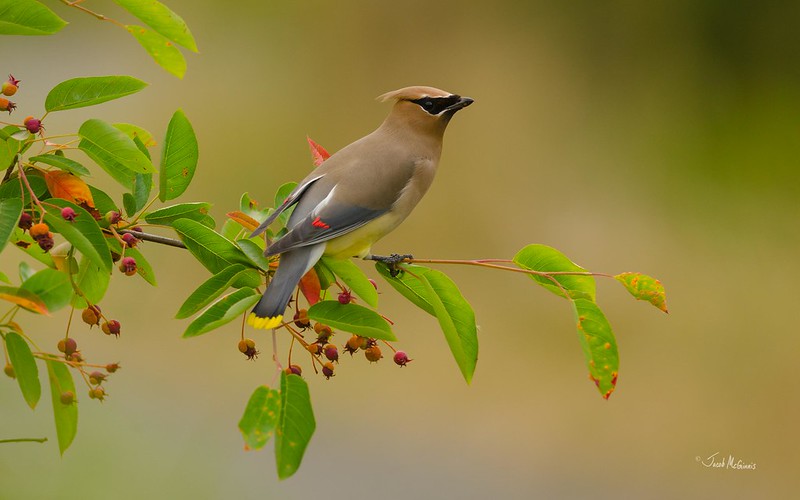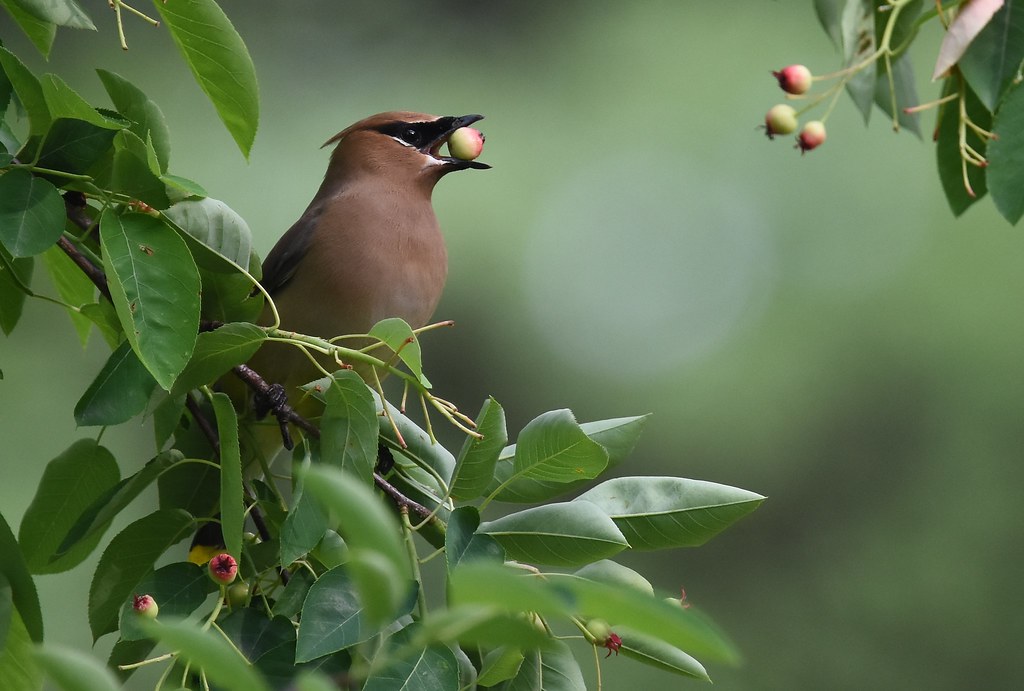Native Animal Profile: Cedar Waxwing
Often heard and not seen, the lovely Cedar Waxwing can be found year-round throughout Maryland. Cedar Waxwings sport a pale brown, crested head with a sleek black mask that runs from their bill and around their eyes. The mask has white outlines which help accentuate it. Waxwings have a brown chest that fades into a gray on the wings and light yellow on the belly. Most waxwings have bright red tips on the end of their wings and a bright yellow swatch at the tip of their tail. Male and female Cedar Waxwings look the same. Juveniles look similar to adults but have a heavily brown-streaked breast.
Cedar Waxwings can be found throughout the year in the northern half of the United States. The southern half of Canada serves as summer breeding territory, while some waxwings travel to the southern United States to overwinter. Occasionally, migrating Cedar Waxwings will travel as far south as Central America, including to countries like Costa Rica.
Cedar Waxwings are primarily frugivorous (fruit eating). As their name suggests, eastern red cedar fruits are a popular winter food for waxwings. They also are well known for consuming and depositing mistletoe fruits and seeds, helping the plant to spread. Unfortunately, Cedar Waxwings have also been found to consume and spread invasive species, too, like Oriental bittersweet and privet. Occasionally, Cedar Waxwings will consume fermented berries in winter and will become intoxicated. In addition, there have been a couple of reports of Cedar Waxwings dying from cyanide toxicity following ingestion of invasive heavenly bamboo (Nandina domestica) berries. In the summer, serviceberry, cherry, strawberry, mulberry, dogwood, and raspberries are all important food for waxwings. They also will take advantage of protein-rich food sources like mayflies, dragonflies, scale insects, and bud worms.
In Maryland, Cedar Waxwings breed from mid-June through the end of July. Females are in charge of nest construction and assemble twigs and grasses to form a shallow cup. The cup is often lined with soft material like cattail fibers and pine needles. It is estimated that it takes a female just under a week to construct a nest. Once completed, the female will lay two to six pale blue eggs that will take up to two weeks to hatch. Nestlings will be ready to fledge in two and a half weeks. Interestingly enough, parasitic Brown-headed Cowbird chicks rarely survive in Cedar Waxwing nests due to the high fruit diet fed to the young.
Cedar Waxwings are very vocal in flight. They primarily make two calls: a high-pitched “Tseee! Tseee!” and a “sighing whistle” according to Cornell’s All About Birds site.
Cedar Waxwings are attracted to backyards with abundant fruits. Native fruit-bearing plants include eastern red cedar, serviceberry, holly, elderberry, blueberry, huckleberry, raspberry, and dogwoods. For a list of plants that provide winter berries for wildlife, check out our HabiChat archive here.
References:
Cedar Waxwing Life History. 2020. Cornell Lab of Ornithology, All About Birds.
https://www.allaboutbirds.org/guide/Cedar_Waxwing/lifehistory. Accessed: January 6, 2020.
Woldemeske, DVM, M. and E. Styer, PhD. Toxicity due to Nandina domestica in Cedar Waxwings (Bombycilla cedrorum)
https://vet.uga.edu/toxicity-due-to-nandina-domestica-in-cedar-waxwings-bombycilla-cedroru/ Accessed: January 6, 2020.
Happy New Year HabiChat fans!
Winter can be a tough time of year for many of our local wildlife species. You can give them a hand by creating habitat and providing natural foods. In this winter edition of HabiChat, learn about Cedar Waxwings, a lovely resident bird that can be found in backyards, as well as our native inkberry holly that provides important cover. In addition, this issue also includes articles on Winter Greens for Wildlife, Eastern Screech Owl Nest Boxes, and how to help with the 3rd Maryland-DC Breeding Bird Atlas.
Winter is also a time for maintenance projects, so don’t forget to clean out and repair nest boxes and prune your shrubs and trees. If you are feeding birds, please also make sure to keep those feeders clean. In addition, water is crucial to many species this time of year. Consider adding a heated bird bath or pet water bowl to your landscape to help local wildlife. If you are looking for fun projects to do with the kids, why not go on a winter safari or make seed wreaths for the birds?
Finally, I am pleased to announce that we have completed the Simple School Wildlife Garden Guide. The guide contains basic information on how to start a school wildlife garden and includes suggested plants and designs for three types of gardens: a monarch garden, a songbird garden, and a pollinator garden. The guide can be found on our Schoolyard Wildlife Habitat page.
Happy Habitats,
Kerry Wixted
Click here to have HabiChat—the quarterly backyard wildlife habitat newsletter from the Wild Acres program—delivered right to your inbox!
In this Issue
Breeding Bird Atlas
Habitat Tip: Eastern Screech Owl Nest Boxes
Habitat Tip: Winter Greens for Wildlife
Native Plant Profile: Inkberry




 1-888-373-7888
1-888-373-7888 233733
233733